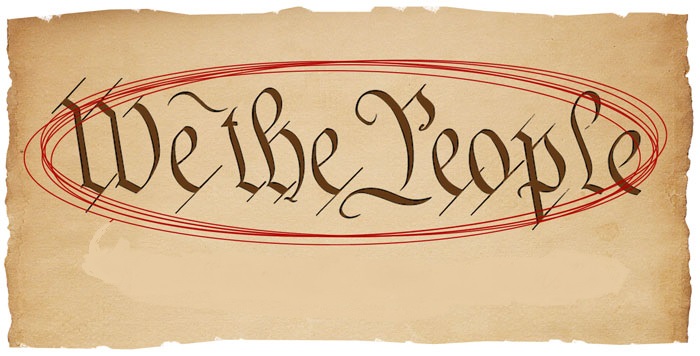This is the second article in a series on basic constitutional principles. Read last week’s article HERE.
The federal government acts like it stands as sovereign in the American system, but that was never intended by those who created it. In fact, the federal government was never meant to serve as anything more than an agent, exercising the specific powers delegated by the true sovereign – the people.
While many Americans assume the federal government sits at the top of the power pyramid, it actually belongs on the bottom. Under the intended constitutional system, “we the people” hold the top position of authority, with the states under them and the federal government only supreme within the limited scope of the explicit powers delegate to it.
The very first words of the Constitution make this clear.
Have you ever wondered why these three words appear in large, ornate letters? When an 18th century British king issued a grant, his name always appeared at the top in the same fashion. The framers merely replaced the king’s name with “We the People,” signifying the sovereign authority from which the delegation of power flowed. (1)
So, the ultimate and final authority always remains in the people. But the states also hold an important position in the American system.
Before the Constitution was drafted and ratified, the sovereign American people had already organized into independent political societies. The people delegated powers to their colonial/state governments, and each was considered an autonomous, sovereign political unit. The British Crown recognized them as such in the Treaty of Paris ending the Revolution.
…the said United States, viz., New Hampshire, Massachusetts Bay, Rhode Island and Providence Plantations, Connecticut, New York, New Jersey, Pennsylvania, Maryland, Virginia, North Carolina, South Carolina and Georgia, to be free sovereign and independent states, that he treats with them as such, and for himself, his heirs, and successors, relinquishes all claims to the government, propriety, and territorial rights of the same and every part thereof.
The Constitution created a “more perfect union” of the states, but it did not alter the fundamental nature of those political societies. In essence, the people of the states took some powers out of the “pot of power” already delegated to their state governments and shifted that authority to the federal government.
The states preceded the union. In fact, they created it. A marriage doesn’t spawn a bride and groom. A bride and groom join together to form a marriage – a union. And when two people get married, their union does not erase their individual character. They don’t become one indistinguishable blob.
The states remain sovereign political societies, only subject to the federal government within the sphere of power delegated.
Article VII established that, “The Ratification of the Conventions of nine States, shall be sufficient for the Establishment of this Constitution between the States so ratifying the Same.”
The creation of the union did not bind any non-ratifying state to it, even at the point those states ratifying included a majority of America’s population. When the U.S. Congress first convened under the current Constitution, North Carolina and Rhode Island were not represented. In fact, Rhode Island did not join the union for over one year, and remained a sovereign nation up until it ratified on May 29, 1790. Need proof? North Carolina and Rhode Island sent no representatives or Senators to Congress until ratification was finalized in those two states.
This dismantles the notion advanced by many progressives insisting that the framers intended a single national government created by the consent of a plurality of Americans. If that was true, North Carolina and Rhode Island would have automatically been bound to the Union, because at that point, far more than two-thirds of the American people were represented by ratifying states.
This distinction becomes important when considering the “place” the states hold within the American political system.
I’ll dig deeper into the distinction between a national conception of the United States and the union of states intended by the framers and ratifiers in next week’s edition of Constitution 101.
Notes
1. Robert G. Natelson, The Original Constitution: What it Actually Meant and Said, (Los Angles: Tenth Amendment Center, 2010), 43.




